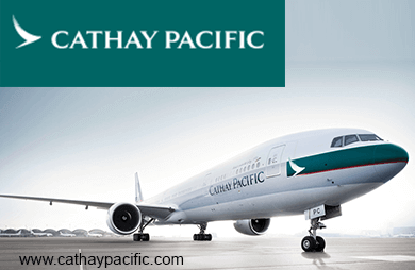
SINGAPORE (March 15): Cathay Pacific Airways Ltd reported its first loss in eight years and scrapped plans for a second-half dividend after competition from Chinese airlines and losses from fuel hedging dented earnings. The stock fell the most in seven months.
The net loss totalled HK$575 million (US$74 million) in 2016, Hong Kong-based Cathay said in a statement Wednesday. That compares with the median profit estimate of HK$450 million in a Bloomberg News survey of nine analysts. Sales at Asia’s largest international airline dropped 9.4% to HK$92.8 billion.
Cathay predicted the operating environment in 2017 would remain challenging, and also said premium travel from Hong Kong was below expectations, prompting the airline to sell such tickets at promotional prices to leisure travellers. The carrier, whose passenger yields have been damped by competition from full-service carriers for business seats and budget airlines for the mass market, said it is starting a three-year “corporate transformation” program to improve returns and operational efficiency.
“For Cathay, it’s committed to a premium strategy in the Hong Kong hub,” said Will Horton, a Hong Kong-based analyst at CAPA Centre for Aviation. “They’re going to ride this out.”
Cathay last posted a loss in 2008, of HK$8.7 billion, according to data compiled by Bloomberg.
Chief Executive Officer Ivan Chu has seen Cathay’s shares plunge more than 20% since his appointment in March 2014, compared with a gain for Hong Kong’s Hang Seng Index. The stock fell as much as 6.9% to HK$10.80, the biggest intraday loss since Aug 17.
Passenger yields, the money earned from flying a traveller for one kilometre and a key measure of profitability, dropped 9.2% to 54.1 Hong Kong cents last year. The cargo yield declined 16% to HK$1.59.
Analyst Projections
In the Bloomberg News survey, analysts had predicted results ranging from a profit of HK$1.5 billion to a net loss of HK$1.5 billion. The disparity in the figures reflected varying estimates of charges due to fuel-hedging losses.
Cathay said it expects further fuel-hedging losses in 2017, although that should be less than for last year. The carrier had unrealised hedging gains of HK$3.57 billion at the end of 2016.
The company was expected to pay a second interim dividend of 27 Hong Kong cents, according to estimates by Bloomberg.
Cathay said passenger yield in 2016 fell 9.2% to 54.1 Hong Kong cents, while losses from fuel hedging totalled HK$8.46 billion in the year, versus HK$8.47 billion in 2015.
Under the revamp plan, the company is reviewing revenue management, distribution and pricing practices. It also intends to increase ancillary revenue, and is working to reduce unit costs excluding fuel over the next three years.
“The goal is to become a more agile and competitive organisation in order to take advantage of changing market trends and customer preferences,” the airline said in the statement.
Despite challenges, Cathay plans to increase passenger capacity by 4% to 5% a year, at least until the Hong Kong airport’s third runway begins operating, and will increase frequencies on our most popular routes in addition to introducing new destinations.